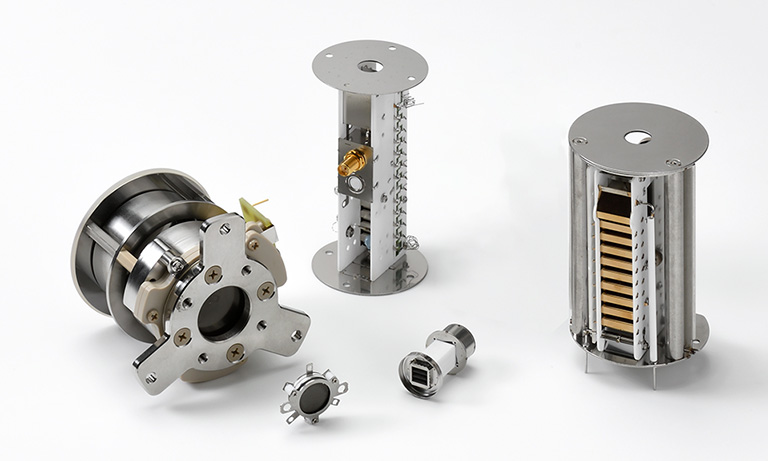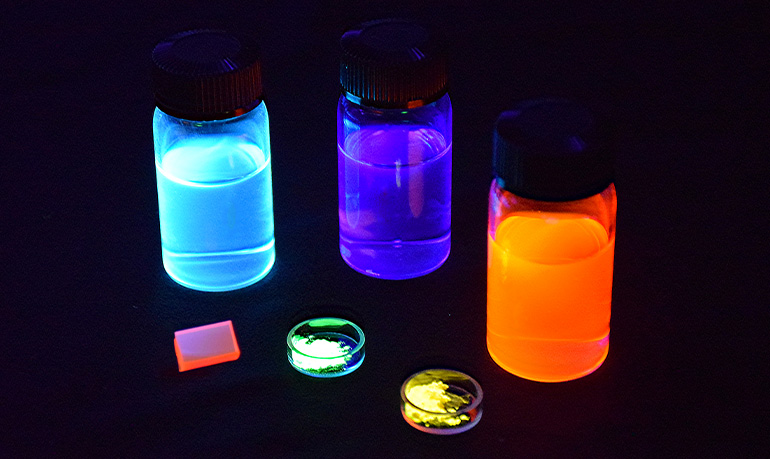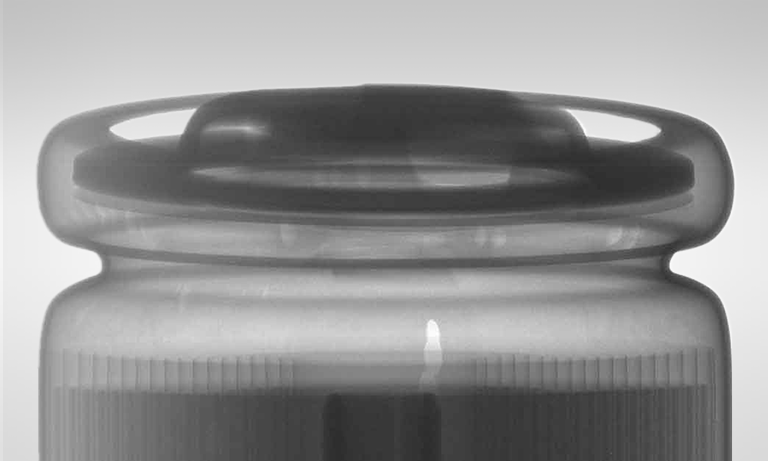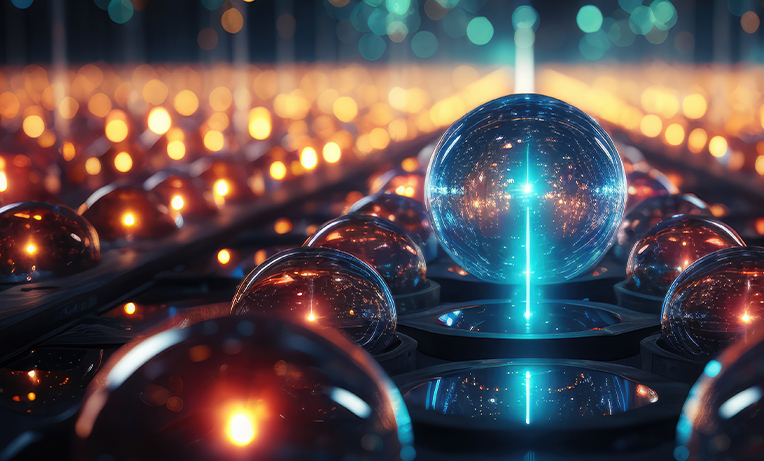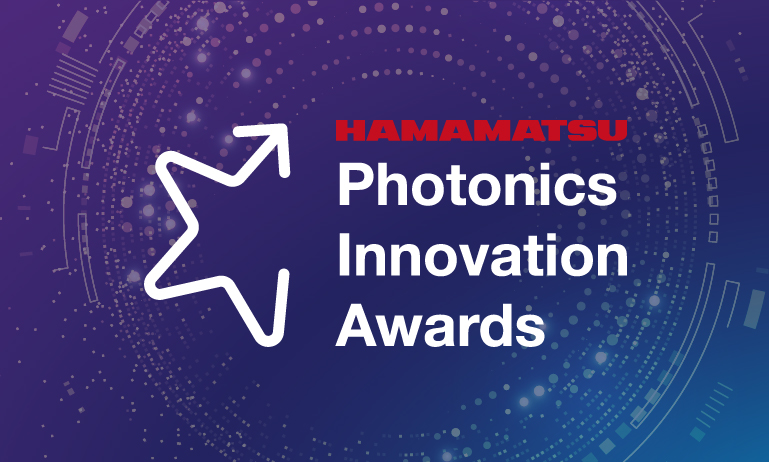United Kingdom (EN)
Select your region or country.


FAQs | VUV Ionizer: Electrostatic charge removers
VUV Ionizers are electrostatic charge removers that use "photoionization" to apply vacuum UV light to remove static electricity. This innovative ionization method makes use of unique features of vacuum UV light to eliminate unwanted electrostatic charges in a vacuum (depressurized state) which has been impossible up to now.
- Do VUV Ionizers emit vacuum UV light immediately after power-on?
- Does vacuum UV light have any effects on target objects?
- What are the residual atoms and molecules that contribute to photoionization by vacuum UV light?
- In which area can electrostatic charges be most efficiently removed?
- How do the characteristics change depending on the irradiation distance?
- What is the reason for the difference between positive charging and negative charging in electrostatic charge removal effect?
- Is it possible to obtain a electrostatic charge removal effect in an atmospheric environment?
- Does the electrostatic charge removal effect differ depending on the degree of vacuum?
- When using VUV Ionizers in a gaseous environment, is there any gas that might cause adverse effects?
- Can I perform ON / OFF irradiation control at short time intervals?
- How should I maintain the light source unit?
- How do I decide when to replace the light source unit?
- Is baking of a vacuum chamber possible while a VUV Ionizer is still installed to it?
- Can you customize VUV Ionizers?
- Is pre-evaluation possible?
- Are there any laws and regulations that need to be followed when installing and using VUV Ionizers?
Do VUV Ionizers emit vacuum UV light immediately after power-on?
No, this is because the deuterium lamp incorporated in VUV Ionizers uses a thermal cathode that requires a warm-up time (filament preheating time) of about 20 seconds after power-on. Vacuum UV light is not emitted during this warm-up time.
Does vacuum UV light have any effects on target objects?
Vacuum UV light energy is high and might damage target objects exposed to vacuum UV light for extended periods of time.
The extent of damage depends on the type of object so we recommend confirming that the target objects are not damaged under the same irradiation conditions as during actual usage. If you send us a target object sample we will confirm effects from vacuum UV irradiation on the target object. Please feel free to consult us about this.
If you do not want to directly irradiate the target objects with vacuum UV light, we suggest indirect irradiation to remove electrostatic charges. In this case, however, the electrostatic charge removal effect will be lower than when using direct irradiation so please consult us about this.
What are the residual atoms and molecules that contribute to photoionization by vacuum UV light?
The residual atoms and molecules in the vacuum chamber originate from atmospheric components or namely components in the air.
In which area can electrostatic charges be most efficiently removed?
Electrons and ions are generated by irradiation of vacuum UV light, so electrostatic charges will be most efficiently removed in the entire area irradiated by vacuum UV light. If an even higher electrostatic charge removal effect is needed, we recommend irradiating vacuum UV light directly onto the target object.
How do the characteristics change depending on the irradiation distance?
Vacuum UV light from the deuterium lamp contained in VUV Ionizers spreads with a light distribution angle starting from the light emission point. This means the longer the irradiation distance, the wider the irradiated area. However, as the distance to the target object increases, the light output attenuates or weakens, which causes the amount of generated ions to decrease and degrade the electrostatic charge removal effect.
What is the reason for the difference between positive charging and negative charging in electrostatic charge removal effect?
Electrons and negative ions work to neutralize positive charges, while positive ions help to neutralize negative charges. This process and the moving speed of the ions and electrons likely cause different electrostatic charge removal effects.
Is it possible to obtain a electrostatic charge removal effect in an atmospheric environment?
No, a electrostatic charge removal cannot be obtained in an atmospheric environment or namely in the air.
Since vacuum UV light emitted from VUV Ionizers is absorbed by oxygen, a electrostatic charge removal effect can only be obtained in a vacuum or in an environment where oxygen was sufficiently replaced with an inert gas such as nitrogen.
If electrostatic charge removal is required in an atmospheric environment, then please use our PhotoIonizers.
Does the electrostatic charge removal effect differ depending on the degree of vacuum?
As the degree of vacuum increases, the number of the residual atoms and molecules decreases and the electrostatic charge removal effect also weakens slightly. However, we have verified that there is no significant decrease in the electrostatic charge removal effect until the vacuum level reaches about 10-6 Pa.
When using VUV Ionizers in a gaseous environment, is there any gas that might cause adverse effects?
The window material of the deuterium lamp in VUV Ionizers uses an MgF2 crystal that is not adversely affected by the following gases.
• Noble gases
• Gases originating from atmospheric air
• Halogen-based gases (HCl, HF)
• Freon-based gases (CF4, CCl2F2, etc.)
Please consult us when using VUV Ionizers in other environments.
Can I perform ON / OFF irradiation control at short time intervals?
Intermittent lighting ranging from a few seconds to several minutes will shorten the lamp operating life. To perform ON / OFF irradiation control at time intervals within a few seconds to several minutes, we recommend using a shutter to interrupt the vacuum UV light.
In the case of the L12542, the guaranteed life is 2000 hours and the expected operating life during continuous lighting is 6000 hours or more. However, when operated intermittently at time intervals from a few seconds to several minutes, the actual operating life may be shorter than the guaranteed life in some cases.
How should I maintain the light source unit?
When cleaning the window for the deuterium lamp in the VUV Ionizer, wipe the window surface with a soft cloth moistened with a volatile solvent such as acetone and then wipe it with dry cloth so that no volatile solvent remains on the window surface. If dirt or contaminants adhere to the window surface, these may cause burn-in (partial opacity) when the lamp is lit up, leading to poor electrostatic charge removal (light output attenuates or weakens due to premature loss of window transmittance).
How do I decide when to replace the light source unit?
We recommend replacing the light source unit before the guaranteed life has expired or after a certain specified operating time has elapsed. The operating time can be calculated from the lamp status signal of the external control terminal on the power supply unit.
Basically, the electrostatic charge removal effect continues as long as the lamp still lights up. Please consult us if concerned about the correct lamp replacement period.
Is baking of a vacuum chamber possible while a VUV Ionizer is still installed to it?
In the case of the L12542 and L15094 which are designed to be installed outside a vacuum chamber, baking of the vacuum chamber is possible unless the temperature of the vacuum chamber surface (vacuum flange mount) exceeds 140 ℃. But do not emit vacuum UV light (do not turn on the light source) during baking.
Please consult us if the temperature of the vacuum chamber surface will be higher than 140 ℃ or you want to emit vacuum UV light during baking.
When using the L10706 whose main unit is designed to be installed inside a vacuum chamber, do not bake the vacuum chamber at a temperature higher than the storage temperature specified for the L10706.
Can you customize VUV Ionizers?
Yes, we will customize VUV Ionizers and vacuum flanges to match your applications and usage conditions so please feel free to consult us about this.
Besides designing and manufacturing vacuum flanges, we also provide technical support for design issues.
Is pre-evaluation possible?
We do simulations and also have demo units available for leasing. Please feel free to contact us about this.
Are there any laws and regulations that need to be followed when installing and using VUV Ionizers?
There are no specific laws or regulations that need to be followed at this time.
However, if you are concerned about the effects of ultraviolet light on the human body, please take necessary action after referring to the following points.
• Be sure to wear protective equipment when handling a VUV Ionizer.
• Shield the viewing port by sticking a color film or similar item on it.
Operating a VUV Ionizer in the air even just temporarily will generate ozone, so be sure to ventilate the room.
- Confirmation
-
It looks like you're in the . If this is not your location, please select the correct region or country below.
You're headed to Hamamatsu Photonics website for GB (English). If you want to view an other country's site, the optimized information will be provided by selecting options below.
In order to use this website comfortably, we use cookies. For cookie details please see our cookie policy.
- Cookie Policy
-
This website or its third-party tools use cookies, which are necessary to its functioning and required to achieve the purposes illustrated in this cookie policy. By closing the cookie warning banner, scrolling the page, clicking a link or continuing to browse otherwise, you agree to the use of cookies.
Hamamatsu uses cookies in order to enhance your experience on our website and ensure that our website functions.
You can visit this page at any time to learn more about cookies, get the most up to date information on how we use cookies and manage your cookie settings. We will not use cookies for any purpose other than the ones stated, but please note that we reserve the right to update our cookies.
1. What are cookies?
For modern websites to work according to visitor’s expectations, they need to collect certain basic information about visitors. To do this, a site will create small text files which are placed on visitor’s devices (computer or mobile) - these files are known as cookies when you access a website. Cookies are used in order to make websites function and work efficiently. Cookies are uniquely assigned to each visitor and can only be read by a web server in the domain that issued the cookie to the visitor. Cookies cannot be used to run programs or deliver viruses to a visitor’s device.
Cookies do various jobs which make the visitor’s experience of the internet much smoother and more interactive. For instance, cookies are used to remember the visitor’s preferences on sites they visit often, to remember language preference and to help navigate between pages more efficiently. Much, though not all, of the data collected is anonymous, though some of it is designed to detect browsing patterns and approximate geographical location to improve the visitor experience.
Certain type of cookies may require the data subject’s consent before storing them on the computer.
2. What are the different types of cookies?
This website uses two types of cookies:
- First party cookies. For our website, the first party cookies are controlled and maintained by Hamamatsu. No other parties have access to these cookies.
- Third party cookies. These cookies are implemented by organizations outside Hamamatsu. We do not have access to the data in these cookies, but we use these cookies to improve the overall website experience.
3. How do we use cookies?
This website uses cookies for following purposes:
- Certain cookies are necessary for our website to function. These are strictly necessary cookies and are required to enable website access, support navigation or provide relevant content. These cookies direct you to the correct region or country, and support security and ecommerce. Strictly necessary cookies also enforce your privacy preferences. Without these strictly necessary cookies, much of our website will not function.
- Analytics cookies are used to track website usage. This data enables us to improve our website usability, performance and website administration. In our analytics cookies, we do not store any personal identifying information.
- Functionality cookies. These are used to recognize you when you return to our website. This enables us to personalize our content for you, greet you by name and remember your preferences (for example, your choice of language or region).
- These cookies record your visit to our website, the pages you have visited and the links you have followed. We will use this information to make our website and the advertising displayed on it more relevant to your interests. We may also share this information with third parties for this purpose.
Cookies help us help you. Through the use of cookies, we learn what is important to our visitors and we develop and enhance website content and functionality to support your experience. Much of our website can be accessed if cookies are disabled, however certain website functions may not work. And, we believe your current and future visits will be enhanced if cookies are enabled.
4. Which cookies do we use?
There are two ways to manage cookie preferences.
- You can set your cookie preferences on your device or in your browser.
- You can set your cookie preferences at the website level.
If you don’t want to receive cookies, you can modify your browser so that it notifies you when cookies are sent to it or you can refuse cookies altogether. You can also delete cookies that have already been set.
If you wish to restrict or block web browser cookies which are set on your device then you can do this through your browser settings; the Help function within your browser should tell you how. Alternatively, you may wish to visit www.aboutcookies.org, which contains comprehensive information on how to do this on a wide variety of desktop browsers.
5. What are Internet tags and how do we use them with cookies?
Occasionally, we may use internet tags (also known as action tags, single-pixel GIFs, clear GIFs, invisible GIFs and 1-by-1 GIFs) at this site and may deploy these tags/cookies through a third-party advertising partner or a web analytical service partner which may be located and store the respective information (including your IP-address) in a foreign country. These tags/cookies are placed on both online advertisements that bring users to this site and on different pages of this site. We use this technology to measure the visitors' responses to our sites and the effectiveness of our advertising campaigns (including how many times a page is opened and which information is consulted) as well as to evaluate your use of this website. The third-party partner or the web analytical service partner may be able to collect data about visitors to our and other sites because of these internet tags/cookies, may compose reports regarding the website’s activity for us and may provide further services which are related to the use of the website and the internet. They may provide such information to other parties if there is a legal requirement that they do so, or if they hire the other parties to process information on their behalf.
If you would like more information about web tags and cookies associated with on-line advertising or to opt-out of third-party collection of this information, please visit the Network Advertising Initiative website http://www.networkadvertising.org.
6. Analytics and Advertisement Cookies
We use third-party cookies (such as Google Analytics) to track visitors on our website, to get reports about how visitors use the website and to inform, optimize and serve ads based on someone's past visits to our website.
You may opt-out of Google Analytics cookies by the websites provided by Google:
https://tools.google.com/dlpage/gaoptout?hl=en
As provided in this Privacy Policy (Article 5), you can learn more about opt-out cookies by the website provided by Network Advertising Initiative:
http://www.networkadvertising.org
We inform you that in such case you will not be able to wholly use all functions of our website.
Close











